Gard Club issued an alert concerning malaria which remains one of the world’s leading killers and seafarers must not lower their guard when visiting an area where there is a risk of exposure to this mosquito-borne disease. The progress in fighting malaria has levelled off.
WHO’s latest World Malaria report noted that there were no successful steps take in mitigating malaria cases in the period 2015 to 2017.
The estimated number of malaria deaths in 2017, at 435 000, remained virtually unchanged over the previous year. ‘A massive wake-up call‘, comments WHO.
As a result, the Club presents the key facts about malaria, in light of shipowners and operators keep their crew safe and also implement prevention measures, including educating the crew.
- Malaria is a life-threatening disease caused by parasites transmitted to people through the bites of infected female Anopheles mosquitoes.
- The Anopheles mosquito is active mainly at night, between dusk and dawn.
- Malaria is an acute febrile illness and symptoms usually appear 10–15 days after the infective mosquito bite. The first symptoms – fever, headache, and chills – may be mild and difficult to recognise as malaria. If not treated within 24 hours, the disease can progress to severe illness, often leading to death. Immediate medical attention should therefore be sought to ensure early diagnosis.
- In 2017, there were an estimated 219 million cases of malaria in 87 countries. The estimated number of malaria deaths stood at 435 000.
- Most malaria cases and deaths, approximately 90%, occur in sub-Saharan Africa. However, the WHO regions of South-East Asia, Eastern Mediterranean, Western Pacific, and the Americas are also at risk.
- Fifteen countries in sub-Saharan Africa and India carried almost 80% of the global malaria burden. Five countries accounted for nearly half of all malaria cases worldwide: Nigeria (25%), Democratic Republic of the Congo (11%), Mozambique (5%), India (4%) and Uganda (4%).
- Malaria is preventable and curable.
Recommended precautions
Shipowners and operators with vessels trading to countries and areas with ongoing malaria transmission should ensure that these vessels are able to deal with the various challenges that this disease can bring.
Depending on the area of trade, risks related to other mosquito-borne diseases, such as dengue, yellow fever, chikungunya and zika, should also be taken into account when planning for the next voyages. The following precautions should be considered:
Before visiting affected areas
- Seafarers should monitor the WHO website and similar ones in order to be informed on any outbreaks of malaria.
- Also, contact a medical practitioner when in doubt.
- Consider the length of stay in an affected area, time spent at sea, in port, on rivers, etc., as well as planned shore leaves by the crew.
- Inform the crew about the risks and the precautions to be taken as well as actions to be taken if illness occurs at sea. Stress that a headache, fever and flu-like symptoms are always grounds for contacting the medical officer.
- Ensure sufficient supplies of effective insect repellents (e.g. hose containing DEET, picaridin or IR3535), light coloured boiler suits, porthole/door mesh screens and bed-nets.
- Consider, in close co-operation with a medical doctor and based on the vessel’s expected exposure time in an affected area, if the crew should take an anti-malarial drug.
During a visit to affected areas
- Review all the ports to be visited and evaluate the risk.
- Implement measures to avoid mosquito bites, e.g. wear protective clothing, stay in air-conditioned screened accommodation areas, use bed-nets in sleeping areas. Use effective insect repellents on exposed skin and/or clothing as directed on the product label and when using a sunscreen, the recommendation is to apply sunscreen first, followed by repellent.
- If crew members are taking anti-malarial drugs, implement a method of control to ensure they take the medication at the prescribed times, e.g. via a log book.
- Remove pools of stagnant water, dew or rain in order for the vessel not to create its own mosquito breeding grounds. Pay particular attention to areas such as lifeboats, coiled mooring ropes, bilges, scuppers, awnings and gutters.
After a visit to affected areas
- Seek medical advice over the radio if malaria is suspected on board. Normally the vessel is in port only for a short time and will most probably be back at sea when symptoms are noticed due to an incubation period of several days.
- Place the patient under close observation and undertake the required onboard treatment, preferably in close co-operation with a medical doctor. Evacuation may be the only solution if the patient’s condition does not improve.
For more information on malaria, you may click the PDF herebelow































































